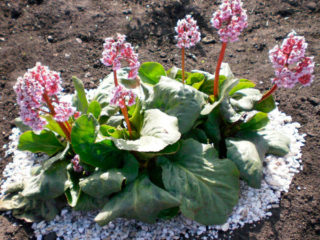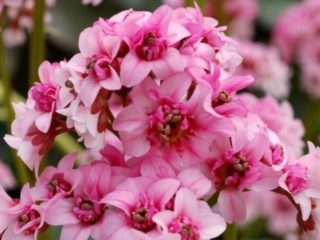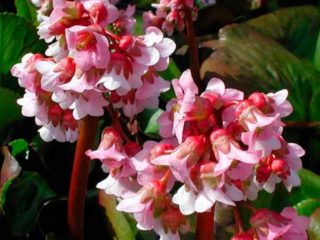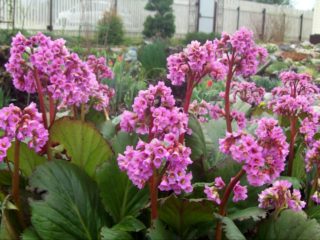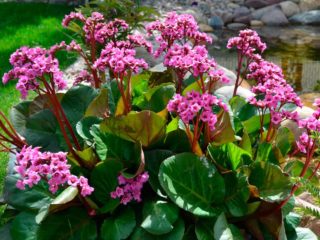Content
Pacific bergenia (Bergenia Pasifaca Kom) is a perennial that belongs to the popular Saxifraga family. In the natural environment, the plant grows on rocky soils, in rocky areas, between bushes in Kazakhstan, Mongolia, Khabarovsk Territory, Amur Region, Primorye, Siberia, and the Urals.
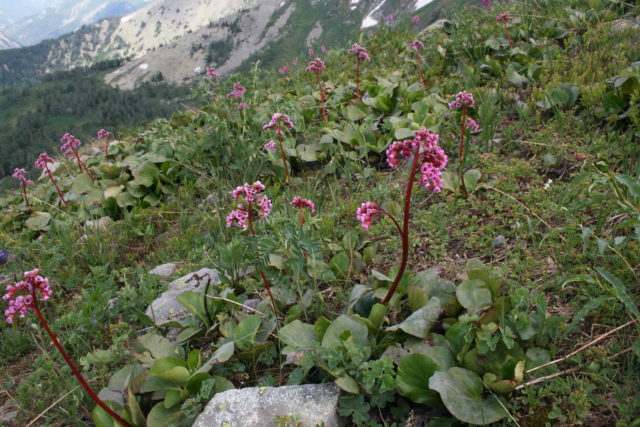
Saxifraga thick-leaved is beautiful both during the flowering period (early June) and after it, attracting with its luxurious green foliage of a unique shape
Description of the Pacific bergenia
Pacific bergenia is an amazingly beautiful, healing, evergreen plant that has the following characteristics:
- the root system is weakly branched, horizontal, creeping, fleshy, thick;
- root length more than 2 m;
- stems without leaves;
- the color of the stems is green, with a red tint;
- stem length up to 45 cm;
- basal leaves;
- leaf color is green with a characteristic shine;
- the color of the leaves in autumn is red, fiery;
- the arrangement of leaves is in the form of a rosette;
- leaf length up to 35 cm;
- leaf width up to 30 cm;
- inflorescences - paniculate and corymbose;
- flowers are small, five-membered, bell-shaped, with long stamens;
- petals are round in shape, with veins;
- flower color pink, purple pink, white;
- the fruit is a dry ellipsoidal capsule;
- The seeds are small and black.
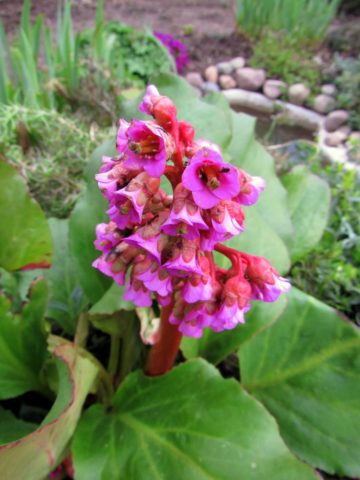
The leaves of Saxifraga thickifolia retain their green, shiny color even in winter under the snow.
Compound
Bergenia roots and leaves are naturally endowed with beneficial properties, which are explained by their unique natural composition.
The rhizomes of the medicinal plant are considered a powerful antioxidant because they contain a large number of useful components:
- arbutin;
- tannins;
- glucose;
- vitamin C;
- polyphenols;
- starch;
- isocoumarin bergenin.

The roots contain up to 27% tannins and large amounts of glucose
The leaf blades of the Pacific medicinal bergenia contain many healing elements:
- tannids;
- abrutin;
- tannins;
- coumarins;
- flavonoids;
- carotene;
- gallic acid;
- vitamin C;
- trace elements (copper, iron, manganese).
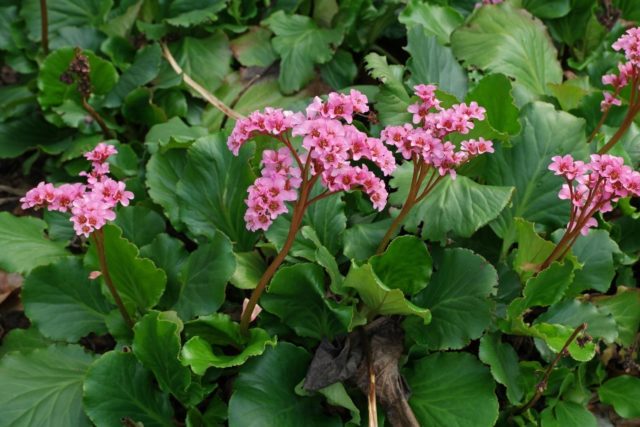
The leaves are generously endowed with resins and essential oils
Pharmacological properties
Preparations containing natural extracts of bergenia are endowed with the following pharmacological properties:
- narrowing of the walls of blood vessels;
- compaction of the structure of the walls of blood vessels;
- diuretic;
- antimicrobial;
- antibacterial;
- anti-inflammatory;
- antipyretic;
- antitumor;
- immunomodulatory;
- wound healing;
- hemostatic;
- antioxidant;
- anti-stress effect.

Extract of the rhizomes of the medicinal Pacific bergenia is used to treat diseases of the skin, digestive tract, respiratory system, and gynecological diseases
Medicinal properties
In folk medicine, the healing properties of bergenia leaves and rhizomes are widely used in the treatment of the following diseases:
- weeping skin rash;
- inflammatory processes in the mouth and nose;
- respiratory diseases;
- tuberculosis;
- pneumonia;
- rheumatoid arthritis;
- gastrointestinal non-infectious diseases;
- infections of the genitourinary and urinary system;
- gynecological diseases;
- headache;
- high blood pressure;
- oncological diseases.
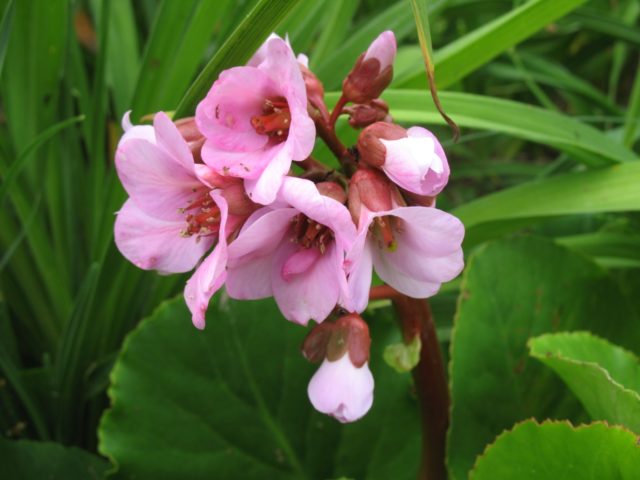
Tincture of medicinal Pacific bergenia leaves (Mongolian tea) relieves fatigue, tones, gives strength
Benefits for women
Rhizomes of the medicinal Pacific bergenia have been used since ancient times for the treatment and prevention of gynecological diseases:
- cervical erosion;
- fibroma;
- thrush;
- heavy menstruation;
- bleeding;
- myoma;
- other pelvic inflammations.
To stop bleeding, crushed rhizomes of the Pacific bergenia (3 tbsp) are boiled for about 25 minutes over low heat in 1 tbsp. boiling water The medicinal drug is taken orally, one sip several times a day.
Decoctions of bergenia roots for douching are especially effective. The brewed decoction is diluted with boiled water in a 1:1 ratio to treat inflammation of the appendages, cervical erosion, fibroids, and cystitis.
The roots of the Pacific bergenia are of great importance for female beauty. For oily facial skin, seborrheic dermatitis, acne, use antibacterial and anti-inflammatory alcohol tinctures of the rhizome of medicinal Pacific bergenia (1 tbsp. crushed raw materials and ½ tbsp. alcohol must be infused in a dark place for 1 week). The lotions are applied to problem areas of the facial skin 2 times a week for 10-15 minutes, then washed off with water.
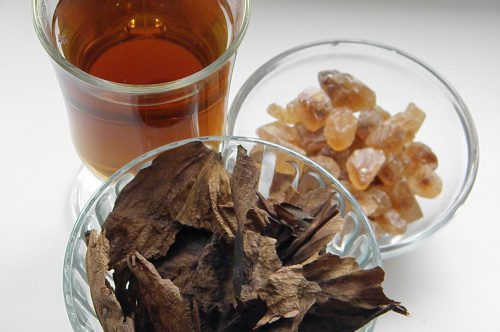
A decoction of the roots and leaves of the plant improves blood circulation in the scalp, strengthens hair follicles, and is therefore used to get rid of dandruff.
Folk recipes
Folk recipes abound in various ways of preparing decoctions and tinctures from the medicinal Pacific bergenia. Ancient recipes contain detailed descriptions of preparing the elixir of youth and beauty from the leaves and roots of this plant.
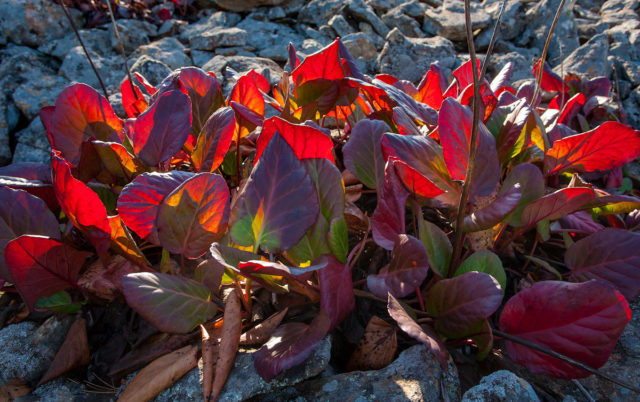
Pacific bergenia is one of the most popular medicinal plants of Primorye
Tincture
Dark brown bergenia tincture is widely used in folk medicine. To prepare the tincture you need to take 1 tbsp. l. crushed, dry bergenia rhizomes; pour 1 tbsp. boiling water; leave for 1-2 hours. Use the resulting infusion 2 tbsp. l. several times a day. Tincture of Pacific bergenia rhizomes is used for the prevention and treatment of the following ailments:
- rheumatism (take 1 tbsp orally 4 times a day);
- diarrhea (take 30 ml orally 3 times a day for 2 weeks).
Decoction
A decoction of the roots of the medicinal Pacific bergenia is prepared from 2 tbsp. l. crushed, dry plant roots and 0.5 l. water. The broth is simmered over low heat in a closed container for 0.5 hours, filtered and cooled to room temperature. The decoction is diluted with 2 tbsp. water and take 3 times a day, 2 tbsp. l. 10-15 minutes before meals. Healing decoctions of medicinal Pacific bergenia are used to treat the following diseases:
- stomatitis (rinse the mouth several times a day with 1 cup of water);
- hemorrhoids (for warm sitz baths for 20 minutes at a decoction temperature of up to + 38 ⁰C for 2 weeks);
- weakening of the immune system (taken orally before meals, 2 tablespoons 4 times a day);
- for poor wound healing (as a lotion or wet dressings for 20-30 minutes).
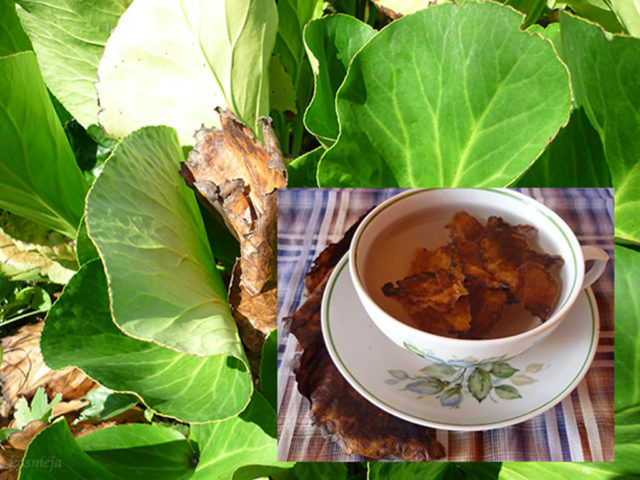
Residents of Siberia use bergenia root to prepare side dishes and add plants as seasonings.
Contraindications
Like any other medicinal herbs, Pacific bergenia has its contraindications for:
- increased blood clotting;
- chronic constipation;
- tachycardia;
- low blood pressure.
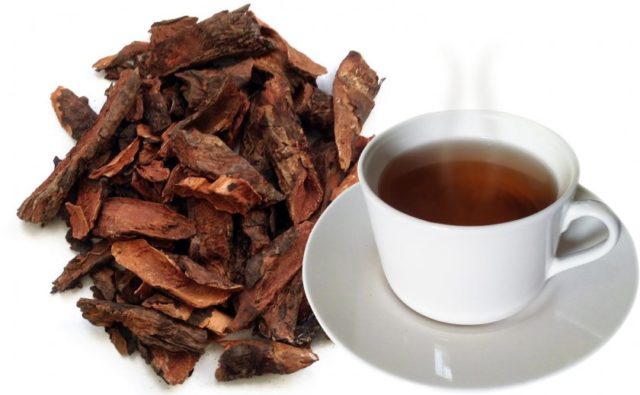
Decoctions and infusions of herbs should not be used if you are hypersensitive
Procurement and storage of raw materials
Since Pacific bergenia develops very slowly, the root system takes about 10 years, and the leaves about 3-4 years to renew and re-harvest in the same place.
The roots are dug out of the ground, freed from soil, washed, dried, hung under a canopy, followed by drying in special dryers at temperatures up to + 30 ⁰C for 1 month.
Pacific bergenia leaves are also dried, crushed and stored in a dark and dry place. The most valuable are leaves collected from plants that have overwintered more than 3 times. The sheet plates are laid out on a wooden or paper pallet and dried under a canopy in natural conditions.
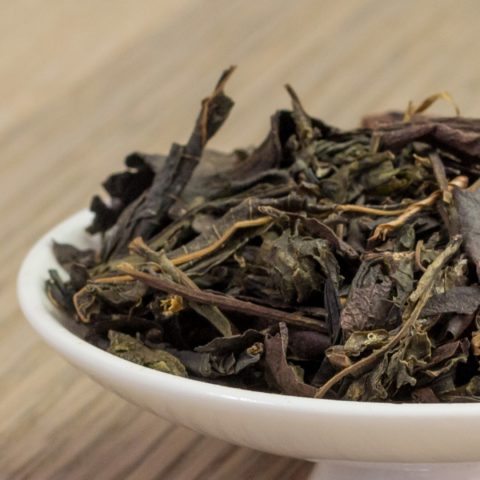
Properly dried raw materials are stored in dry, hermetically sealed containers for 3 years
Conclusion
Pacific bergenia, or thick-leaved saxifrage, is an original decoration for flower beds and flower beds. Many modern landscape designers give preference to this crop when decorating areas of any style as a ground cover plant. In Siberia, Mongolia and China, Chigir or Mongolian tea with an exquisite cedar aroma is very popular.
